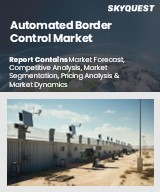
자동 출입국 심사 세계 시장 규모는 2023년에 21억 달러로 평가되었으며, 2024년 23억 8,000만 달러에서 2032년에는 64억 6,000만 달러로 성장하여 예측 기간(2025-2032년) 동안 CAGR 13.3%로 성장할 전망입니다.
전 세계 자동 출입국 심사 시장은 안전하고 효율적인 비접촉식 국경 통과 솔루션에 대한 수요에 힘입어 크게 성장하고 있습니다. 국제 여행의 급증, 출입국 보안 조치 강화, 승객 경험의 개선이 이러한 추세의 주요 요인입니다. 각국 정부는 국경 업무를 간소화하기 위해 AI를 활용한 신원 확인과 함께 얼굴 인식, 지문 스캔, 홍채 인식과 같은 생체인식 기술의 채택을 늘리고 있습니다. 이러한 기술 혁신을 통해 대기 시간을 단축하고 여행자의 절차를 간소화할 수 있습니다. 자동화된 시스템으로의 전환은 기존 절차를 최소화하여 승객이 여권을 빠르게 스캔하고 몇 분 안에 필요한 검사를 완료할 수 있도록 돕습니다. 또한 공항 이용객의 증가, 불법적인 국경 활동에 대한 우려 증가, 효율적인 보안 프로세스의 필요성이 시장 성장을 더욱 촉진하고 있습니다.
Global Automated Border Control Market size was valued at USD 2.1 billion in 2023 and is poised to grow from USD 2.38 billion in 2024 to USD 6.46 billion by 2032, growing at a CAGR of 13.3% during the forecast period (2025-2032).
The global automated border control market is experiencing significant growth driven by the demand for secure, efficient, and contactless border crossing solutions. The surge in international travel, enhanced immigration security measures, and the emphasis on improving passenger experiences are key contributors to this trend. Governments are increasingly adopting biometric technologies, including facial recognition, fingerprint scans, and iris recognition, alongside AI-driven identity verification to streamline border operations. This innovation helps reduce wait times and simplifies the processing for travelers. The transition to automated systems minimizes traditional procedures, enabling passengers to quickly scan their passports and complete necessary checks in minutes. Additionally, rising airport traffic, heightened concerns over illegal border activities, and the need for efficient security processes further propel market growth.
Top-down and bottom-up approaches were used to estimate and validate the size of the Global Automated Border Control market and to estimate the size of various other dependent submarkets. The research methodology used to estimate the market size includes the following details: The key players in the market were identified through secondary research, and their market shares in the respective regions were determined through primary and secondary research. This entire procedure includes the study of the annual and financial reports of the top market players and extensive interviews for key insights from industry leaders such as CEOs, VPs, directors, and marketing executives. All percentage shares split, and breakdowns were determined using secondary sources and verified through Primary sources. All possible parameters that affect the markets covered in this research study have been accounted for, viewed in extensive detail, verified through primary research, and analyzed to get the final quantitative and qualitative data.
Global Automated Border Control Market Segments Analysis
Global Automated Border Control Market is segmented by Component, Solution Type, Application, End-User and region. Based on Component, the market is segmented into Hardware, Software and Services. Based on Solution Type, the market is segmented into ABC E-gates and ABC Kiosks. Based on Application, the market is segmented into Airport, Land Port and Seaport. Based on End-User, the market is segmented into Government and Private Sector. Based on region, the market is segmented into North America, Europe, Asia Pacific, Latin America and Middle East & Africa.
Driver of the Global Automated Border Control Market
The increasing volume of international travel for both business and leisure purposes has put significant pressure on border management agencies to manage and process large numbers of travelers efficiently. Automated Border Control (ABC) systems play a crucial role in this by facilitating rapid identity verification through the use of biometric eGates and kiosks, which help minimize long lines and wait times. Countries such as the UAE and Singapore have implemented facial recognition-based ABC systems at their major airports, significantly enhancing the efficiency of entry and exit processes and improving overall traveler experience.
Restraints in the Global Automated Border Control Market
The Global Automated Border Control market faces significant restraints, primarily due to the substantial capital investments required for advanced biometric technologies, cameras, sensors, and AI software. In addition to the initial hardware costs, countries must also enhance their backend systems, invest in staff training, and uphold security protocols, creating a financial burden that particularly affects developing nations. This high upfront expenditure serves as a considerable obstacle to the adoption of automated systems. Furthermore, the technical challenges associated with integrating new technologies with existing immigration databases and international travel data can be resource-intensive and complex, leading to delays in deployment.
Market Trends of the Global Automated Border Control Market
The Global Automated Border Control (ABC) market is witnessing a significant trend towards the integration of AI-powered risk assessment and decision-making capabilities. This innovation extends beyond traditional identity verification, as ABC systems increasingly utilize real-time AI analytics for evaluating traveler behavior, detecting forged documents, and identifying high-risk profiles. Countries like Germany are implementing AI algorithms that generate risk scores based on historical immigration data, allowing for more efficient border management by minimizing delays for low-risk travelers while enhancing the effectiveness of targeted enforcement measures. As these technologies become more sophisticated, they are set to redefine border security, fostering a more seamless and secure travel experience globally.